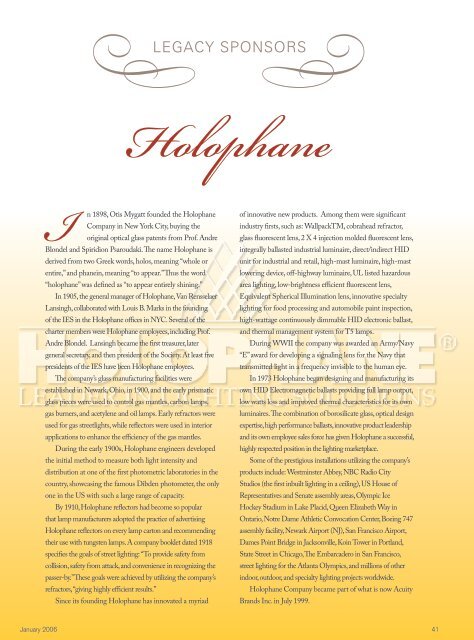COMMeMOratiVe ISSue - Illuminating Engineering Society
COMMeMOratiVe ISSue - Illuminating Engineering Society
COMMeMOratiVe ISSue - Illuminating Engineering Society
You also want an ePaper? Increase the reach of your titles
YUMPU automatically turns print PDFs into web optimized ePapers that Google loves.
Legacy Sponsors<br />
Holophane<br />
I<br />
n 1898, Otis Mygatt founded the Holophane<br />
Company in New York City, buying the<br />
original optical glass patents from Prof. Andre<br />
Blondel and Spiridion Psaroudaki. The name Holophane is<br />
derived from two Greek words, holos, meaning “whole or<br />
entire,” and phanein, meaning “to appear.” Thus the word<br />
“holophane” was defined as “to appear entirely shining.”<br />
In 1905, the general manager of Holophane, Van Rensselaer<br />
Lansingh, collaborated with Louis B. Marks in the founding<br />
of the IES in the Holophane offices in NYC. Several of the<br />
charter members were Holophane employees, including Prof.<br />
Andre Blondel. Lansingh became the first treasurer, later<br />
general secretary, and then president of the <strong>Society</strong>. At least five<br />
presidents of the IES have been Holophane employees.<br />
The company’s glass manufacturing facilities were<br />
established in Newark, Ohio, in 1900, and the early prismatic<br />
glass pieces were used to control gas mantles, carbon lamps,<br />
gas burners, and acetylene and oil lamps. Early refractors were<br />
used for gas streetlights, while reflectors were used in interior<br />
applications to enhance the efficiency of the gas mantles.<br />
During the early 1900s, Holophane engineers developed<br />
the initial method to measure both light intensity and<br />
distribution at one of the first photometric laboratories in the<br />
country, showcasing the famous Dibden photometer, the only<br />
one in the US with such a large range of capacity.<br />
By 1910, Holophane reflectors had become so popular<br />
that lamp manufacturers adopted the practice of advertising<br />
Holophane reflectors on every lamp carton and recommending<br />
their use with tungsten lamps. A company booklet dated 1918<br />
specifies the goals of street lighting: “To provide safety from<br />
collision, safety from attack, and convenience in recognizing the<br />
passer-by.” These goals were achieved by utilizing the company’s<br />
refractors, “giving highly efficient results.”<br />
Since its founding Holophane has innovated a myriad<br />
of innovative new products. Among them were significant<br />
industry firsts, such as: WallpackTM, cobrahead refractor,<br />
glass fluorescent lens, 2 X 4 injection molded fluorescent lens,<br />
integrally ballasted industrial luminaire, direct/indirect HID<br />
unit for industrial and retail, high-mast luminaire, high-mast<br />
lowering device, off-highway luminaire, UL listed hazardous<br />
area lighting, low-brightness efficient fluorescent lens,<br />
Equivalent Spherical Illumination lens, innovative specialty<br />
lighting for food processing and automobile paint inspection,<br />
high-wattage continuously dimmable HID electronic ballast,<br />
and thermal management system for T5 lamps.<br />
During WWII the company was awarded an Army/Navy<br />
“E” award for developing a signaling lens for the Navy that<br />
transmitted light in a frequency invisible to the human eye.<br />
In 1973 Holophane began designing and manufacturing its<br />
own HID Electromagnetic ballasts providing full lamp output,<br />
low watts loss and improved thermal characteristics for its own<br />
luminaires. The combination of borosilicate glass, optical design<br />
expertise, high performance ballasts, innovative product leadership<br />
and its own employee sales force has given Holophane a successful,<br />
highly respected position in the lighting marketplace.<br />
Some of the prestigious installations utilizing the company’s<br />
products include: Westminster Abbey, NBC Radio City<br />
Studios (the first inbuilt lighting in a ceiling), US House of<br />
Representatives and Senate assembly areas, Olympic Ice<br />
Hockey Stadium in Lake Placid, Queen Elizabeth Way in<br />
Ontario, Notre Dame Athletic Convocation Center, Boeing 747<br />
assembly facility, Newark Airport (NJ), San Francisco Airport,<br />
Dames Point Bridge in Jacksonville, Koin Tower in Portland,<br />
State Street in Chicago, The Embarcadero in San Francisco,<br />
street lighting for the Atlanta Olympics, and millions of other<br />
indoor, outdoor, and specialty lighting projects worldwide.<br />
Holophane Company became part of what is now Acuity<br />
Brands Inc. in July 1999.<br />
January 2006 41
















